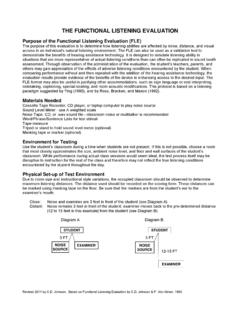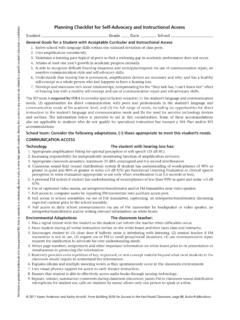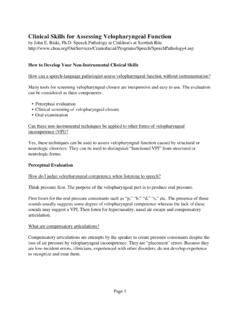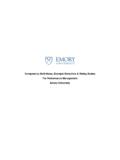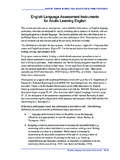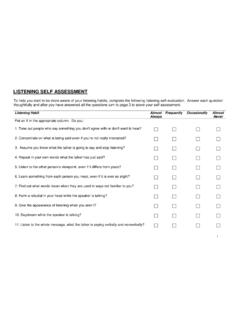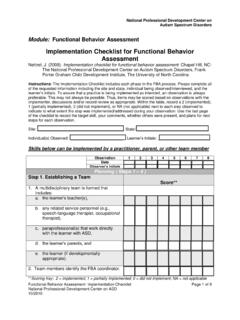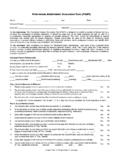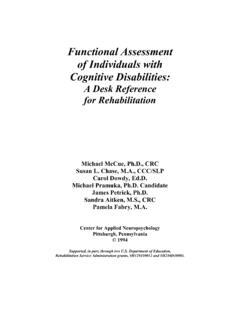Transcription of Interpretation of Functional Listening Evaluation Results ...
1 80 Journal of Educational Audiology vol. 19, 2013 Interpretation of Functional Listening Evaluation Results ofNormal-Hearing Children with Reading Diffi cultiesJeanne Dodd-Murphy, UniversityWaco, TXMichaela J. Ritter, UniversityWaco, TXThis report follows up on the article by Dodd-Murphy & Ritter (2012) that presented Functional Listening Evaluation (FLE) group data for normal-hearing children with reading diffi culties. The current study describes a retrospective analysis of the same database, focusing on clinical Interpretation of individual FLE Results . The FLE (Johnson & VonAlmen, 1997), frequently used by educational audiologists to assess the need for classroom accommodations in children with hearing loss, is a protocol that measures the effects of noise, distance, and visual information on speech recognition under typical classroom Listening conditions. FLE summary forms were reviewed for each child to determine whether the Results would support the recommenda-tion of hearing assistance technology (HAT) in the classroom.
2 Judgments were made based on potentially signifi cant noise and/or distance effects on speech recognition from the FLE Interpretation matrix. Specifi c criteria and examples of FLE profi les are provided. The FLE pattern of Results was judged to support HAT recommendation for 44% of the children. Mean speech recognition scores for the children who were not HAT candidates were 90% or above in all Listening conditions. Mean scores for children judged to need HAT in the classroom were below 90% in all conditions. The FLE may provide evidence of classroom Listening needs that assist the clinician in making appropriate intervention recommendations for this population. Further pro-spective research is needed to evaluate the effi cacy of the FLE in predicting which children may benefi t from the use of HAT in the classroom. IntroductionEducational audiologists have long been aware of the benefi t that classroom hearing assistance technology (HAT) can provide for children with hearing impairment (Johnson & Seaton, 2012; Lewis, 2010).
3 In recent years, there has been a greater awareness of how poor classroom acoustics can reduce access to auditory learning not only for children with hearing loss, but for children in general (Jamieson, Kranjc, Yu, & Hodgetts, 2004; Nelson & Soli, 2000; Stelmachowicz, Hoover, Lewis, Kortekaas, & Pittman, 2000; Stuart, 2008). Though not as extensive as the literature related to the use of HAT with children who are deaf or hard of hearing, a growing body of evidence has indicated that remote microphone technology can improve classroom behavior and academic performance in children with normal hearing belonging to various clinical populations (Darai, 2000; Dockrell & Shield, 2012; Flexer, Millin, & Brown, 1990; Johnston, John, Kreisman, Hall, & Crandell, 2009; Sharma, Purdy, & Kelly, 2012). Professional guidelines published by the American Academy of Audiology (2008) identify children with normal hearing and special Listening requirements as one of three groups who are candidates for the use of remote microphone HAT.
4 Crandall, Smaldino, & Flexer (2005) enumerate at-risk populations that would benefi t from an increased signal-to-noise ratio (SNR) such as that provided by classroom HAT, including children with typical hearing who have learning disabilities, language disorders, attention defi cits, and/or children who are English language learners. Not all children in these groups would require HAT for improved access to auditory learning; thus, careful assessment of the educational need for HAT is critical in this population (Johnson, 2010; Johnson & Seaton, 2012; Lewis, 2010; Schafer, 2010). This type of assessment typically includes classroom observation, teacher questionnaire, and a direct measurement of Functional Listening abilities (AAA, 2008; American Speech-Language-Hearing Association, 2002; Johnson, 2010; Schafer, 2010). The Functional Listening Evaluation (FLE, Johnson & VonAlmen, 1997) is an assessment tool commonly used by educational audiologists to determine the need for hearing assistive technology (HAT) and/or other classroom accommodations.
5 The FLE was designed to show the effects of noise, distance, and visual input on the speech recognition performance of children with hearing loss under conditions simulating a typical classroom environment. Eiten (2008) stressed the importance of using quantifi able measures and providing supporting information related to a child s speech recognition performance without HAT when determining candidacy. The FLE fulfi lls both of these objectives. Additionally, the FLE can satisfy the requirement of Individuals with Disabilities Education Act (IDEA) for Functional Evaluation in the child s regular classroom environment. The FLE 81 Interpretation of Functional Listening Evaluation Results of Normal-Hearing Children with Reading Diffi cultiesis valued as a direct measurement of a child s performance to corroborate and supplement other fi ndings such as child, teacher, or parental reports of speech recognition diffi culties.
6 It is crucial for audiologists to justify any recommendation of hearing assistive technology (AAA, 2008; Eiten, 2008; Johnson, 2010; Johnson & Seaton, 2012). This would be particularly true when working with children who have normal hearing sensitivity, who are typically not expected to need hearing-related interventions. In addition, their classroom Listening problems may be much more subtle than those of children with hearing loss. In their research, Dodd-Murphy and Ritter (2012) used the FLE to evaluate a group of children with normal hearing who were diagnosed with language and reading impairment. They concluded that the FLE was potentially useful to justify the recommendation of HAT ( , personal FM systems or classroom audio distribution systems [CADS]) and other accommodations in children with normal hearing and special Listening needs, particularly with modifi cations to the speech material and the protocol to increase the FLE s sensitivity in assessing children with normal hearing.
7 This report describes the Results of a retrospective analysis of individual FLE Results from the same database to evaluate each child s educational need for Participants were recruited from children who attended a university-sponsored language and literacy intervention program, held in the summer as an intensive month-long day camp. A group of 39 children (27 males) between the ages of 7;0 and 10;11 (years; months) participated in the project. All children were diagnosed by certifi ed, licensed speech-language pathologists with oral and written language disorders affecting literacy and had passed a hearing screening. Following approval from the university Institutional Review Board, informed parental consent was obtained for each child, and monetary compensation was given for researchers used the 2002 revision of the FLE (Johnson & VonAlmen, 1997) as described below to evaluate the need for HAT.
8 The most recent version of the FLE protocol and form is available from ADEvantage ( ). The FLE allows examiners a choice of speech materials. For this study, the BKB-SAE sentences (Bamford, Kowal, & Bench, 1979) were the stimuli. There are eight different lists of short sentences; the sentence list order was counterbalanced. A different list was presented in each of the FLE Listening conditions. The scorebox in Figure 1 shows the eight conditions; the sequence order for each condition is designated by the number in the top left hand corner of each data cell. The Listening condition sequence was kept the same for each child. ProcedureFor a more detailed discussion of the methodology, see Dodd-Murphy & Ritter (2012). The FLE was administered by two under-graduate student researchers trained and supervised by a licensed, certifi ed audiologist.
9 Testing was conducted in an unoccupied classroom in the same building as the day camp the children were attending. During the FLE, the child sat in a desk, and the examin-er read the sentences from three feet away in the Close conditions and from 15 feet away in the Distant conditions. For the Noise conditions, a recording of multi-talker babble was adjusted so that its level averaged 60 dBA SPL at the child s ear. An acoustically transparent screen covered the examiner s face during the Audi-tory only conditions. The student researchers worked as a pair; one examiner pre-sented the sentences via monitored live voice, and the other ex-aminer marked the child s responses on a score sheet. An average of 75 dBA SPL speech presentation level was maintained using a sound level meter one foot away from the speaker. Every sentence was presented only once, and the child was asked to repeat each sentence exactly as the speaker read it.
10 A wireless lapel micro-phone, worn by the child during the testing session, transmitted responses to a digital voice recorder, which enabled the session recording to be saved as a sound fi le. Responses were scored as correct if the entire sentence was repeated correctly. The FLE scorebox on the summary form (Figure 1) shows a score for each condition. Figure 1. Individual FLE profile for child with educational need for HAT 82 Journal of Educational Audiology vol. 19, 2013A certifi ed audiologist with experience in both clinical and educational audiology reviewed the FLE summary and Interpretation forms for individual children to evaluate whether the pattern of Results would support the recommendation of classroom HAT. The FLE Interpretation matrix (see Figure 1) allows the examiner to observe the effects of noise, distance, and/or the presence of visual cues on speech recognition overall.

